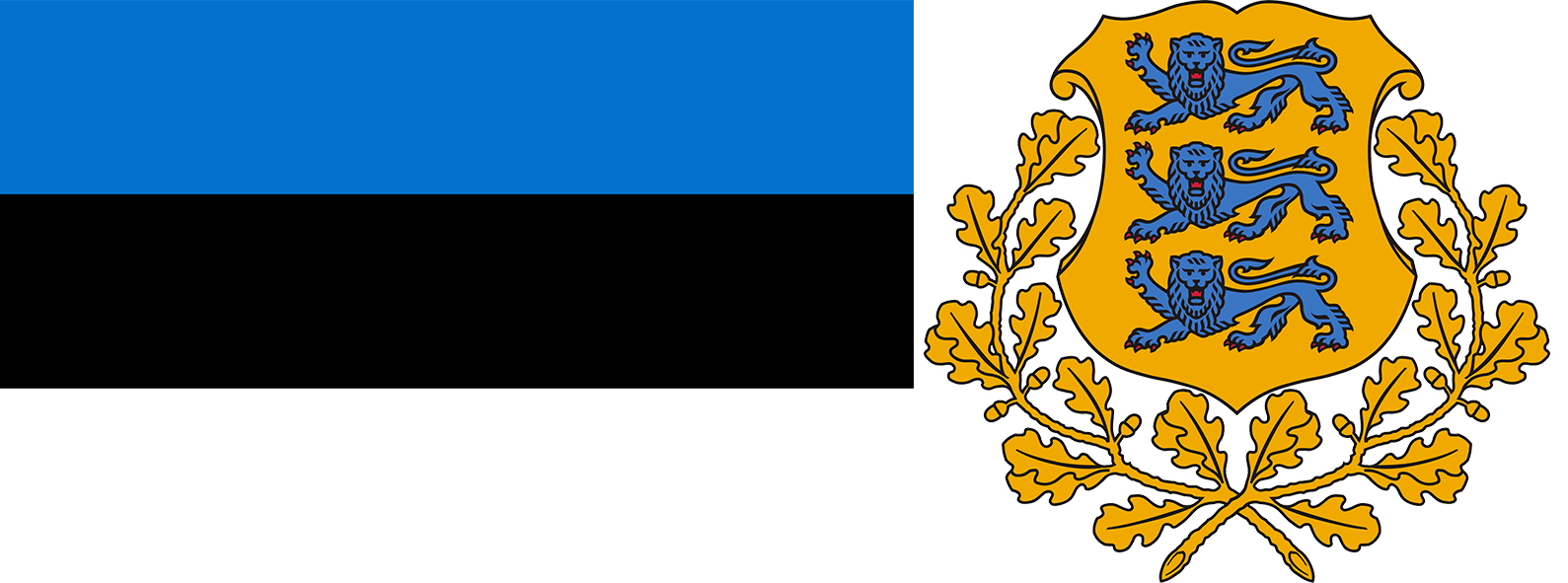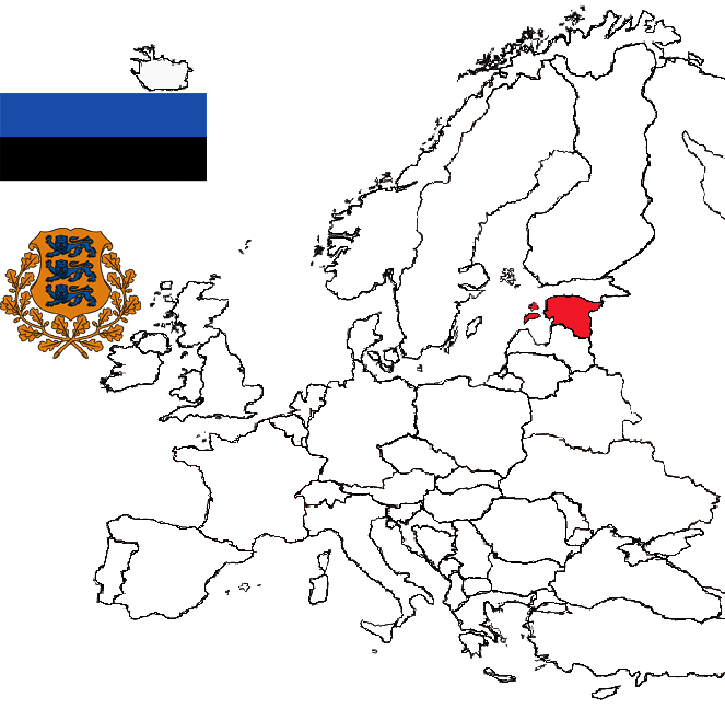FabulousFusionFood's Estonian Recipes Home Page
 The flag of Estonia (left) and the coat of arms of Estonia (right).
The flag of Estonia (left) and the coat of arms of Estonia (right).
Welcome to the summary page for FabulousFusionFood's Estonian recipes, part of Europe. This page provides links to all the Estonian recipes presented on this site, with 5 recipes in total.
This is a continuation of an entire series of pages that will, I hope, allow my visitors to better navigate this site. As well as displaying recipes by name, country and region of origin I am now planning a whole series of pages where recipes can be located by meal type and main ingredient. This page gives a listing of all the Indian recipes added to this site.
Estonia, officially Eesti Vabariik (The Republic of Estonia) is a Baltic country in Northern Europe. Tallinn is its capital and largest city and the official language is Estonian.
The traditional cuisine of Estonia is based on peasant cookery which has been influenced by a range of other countries though the most typical Estonian foods still include black bread, pork, potatoes and dairy products. Preeves remain winter staples, echoes of the many privations that Estonia's citizens have undergone over the centuries.
Estonia, officially the Republic of Estonia, (Eesti Vabariik in Estonian) is a country by the Baltic Sea in Northern Europe. It is bordered to the north by the Gulf of Finland across from Finland, to the west by the sea across from Sweden, to the south by Latvia, and to the east by Lake Peipus and Russia. The territory of Estonia consists of the mainland, the larger islands of Saaremaa and Hiiumaa, and over 2,300 other islands and islets on the east coast of the Baltic Sea, covering a total area of 45,335 square kilometres (17,504 sq mi). Tallinn, the capital city, and Tartu are the two largest urban areas. The Estonian language is the indigenous and official language, also being the first language of the majority of the population of 1.4 million.
 Location of Estonia in Europe with the land mass of Estonia picked out in red.Present-day Estonia has been inhabited by humans since at least 9,000 BCE. The medieval indigenous population of Estonia was one of the last pagan civilisations in Europe to adopt Christianity following the Northern Crusades in the 13th century. After centuries of successive rule by the Teutonic Order, Denmark, Sweden, and the Russian Empire, a distinct Estonian national identity began to emerge in the mid-19th century. This culminated in the 1918 Estonian Declaration of Independence from the then-warring Russian and German empires. Democratic throughout most of the interwar period, Estonia declared neutrality at the outbreak of World War II, however the country was repeatedly contested, invaded, and occupied; first by the Soviet Union in 1940, then Nazi Germany in 1941, and ultimately reoccupied in 1944 by, and annexed into, the USSR as an administrative subunit (Estonian SSR). Throughout the 1944–91 Soviet occupation, Estonia's de jure state continuity was preserved by diplomatic representatives and the government-in-exile. Following the 1988–90 bloodless Estonian 'Singing Revolution' against Soviet rule, the nation's full independence was restored on 20 August 1991.
Location of Estonia in Europe with the land mass of Estonia picked out in red.Present-day Estonia has been inhabited by humans since at least 9,000 BCE. The medieval indigenous population of Estonia was one of the last pagan civilisations in Europe to adopt Christianity following the Northern Crusades in the 13th century. After centuries of successive rule by the Teutonic Order, Denmark, Sweden, and the Russian Empire, a distinct Estonian national identity began to emerge in the mid-19th century. This culminated in the 1918 Estonian Declaration of Independence from the then-warring Russian and German empires. Democratic throughout most of the interwar period, Estonia declared neutrality at the outbreak of World War II, however the country was repeatedly contested, invaded, and occupied; first by the Soviet Union in 1940, then Nazi Germany in 1941, and ultimately reoccupied in 1944 by, and annexed into, the USSR as an administrative subunit (Estonian SSR). Throughout the 1944–91 Soviet occupation, Estonia's de jure state continuity was preserved by diplomatic representatives and the government-in-exile. Following the 1988–90 bloodless Estonian 'Singing Revolution' against Soviet rule, the nation's full independence was restored on 20 August 1991.
Estonia is a developed country with a high-income advanced economy, ranking 31st in the Human Development Index. The sovereign state of Estonia is a democratic unitary parliamentary republic, administratively subdivided into 15 maakond (counties). It is one of the least populous members of the European Union and NATO.
The name Estonia (Estonian: Eesti) has been connected to Aesti, a people first mentioned by Ancient Roman historian Tacitus around 98 CE. Some modern historians believe he was referring to Balts, while others have proposed that the name then applied to the whole eastern Baltic Sea region. Scandinavian sagas and Viking runestones referring to Eistland are the earliest known sources that definitely use the name in its modern geographic meaning. From Old Norse the toponym spread to other Germanic vernaculars and reached literary Latin by the end of 12th century.
A cardamom-spiced bread roll with almond paste vastlakukkel is a traditional Estonian sweet roll, especially popular from Christmas to Easter. Traditionally in winter, jams, preserves, and pickles are brought to the table. Gathering and preserving fruits, mushrooms, and vegetables for winter has always been popular, but today gathering and preserving is becoming less common because everything can be bought from stores. However, preparing food for winter is still very popular in the countryside.
This is a continuation of an entire series of pages that will, I hope, allow my visitors to better navigate this site. As well as displaying recipes by name, country and region of origin I am now planning a whole series of pages where recipes can be located by meal type and main ingredient. This page gives a listing of all the Indian recipes added to this site.
Estonia, officially Eesti Vabariik (The Republic of Estonia) is a Baltic country in Northern Europe. Tallinn is its capital and largest city and the official language is Estonian.
The traditional cuisine of Estonia is based on peasant cookery which has been influenced by a range of other countries though the most typical Estonian foods still include black bread, pork, potatoes and dairy products. Preeves remain winter staples, echoes of the many privations that Estonia's citizens have undergone over the centuries.
Estonia, officially the Republic of Estonia, (Eesti Vabariik in Estonian) is a country by the Baltic Sea in Northern Europe. It is bordered to the north by the Gulf of Finland across from Finland, to the west by the sea across from Sweden, to the south by Latvia, and to the east by Lake Peipus and Russia. The territory of Estonia consists of the mainland, the larger islands of Saaremaa and Hiiumaa, and over 2,300 other islands and islets on the east coast of the Baltic Sea, covering a total area of 45,335 square kilometres (17,504 sq mi). Tallinn, the capital city, and Tartu are the two largest urban areas. The Estonian language is the indigenous and official language, also being the first language of the majority of the population of 1.4 million.
 Location of Estonia in Europe with the land mass of Estonia picked out in red.
Location of Estonia in Europe with the land mass of Estonia picked out in red.Estonia is a developed country with a high-income advanced economy, ranking 31st in the Human Development Index. The sovereign state of Estonia is a democratic unitary parliamentary republic, administratively subdivided into 15 maakond (counties). It is one of the least populous members of the European Union and NATO.
The name Estonia (Estonian: Eesti) has been connected to Aesti, a people first mentioned by Ancient Roman historian Tacitus around 98 CE. Some modern historians believe he was referring to Balts, while others have proposed that the name then applied to the whole eastern Baltic Sea region. Scandinavian sagas and Viking runestones referring to Eistland are the earliest known sources that definitely use the name in its modern geographic meaning. From Old Norse the toponym spread to other Germanic vernaculars and reached literary Latin by the end of 12th century.
Food and Cuisine:
Historically, the cuisine of Estonia has been dependent on seasons and the simple food from the local farms and the sea. Today, it also includes many 'global' foods. The most typical foods in modern Estonia are black bread, pork, potatoes, and dairy products.[448] Traditionally in summer and spring, Estonians like to eat everything fresh – berries, herbs, vegetables, and everything else that comes straight from the garden. Hunting and fishing have also been very common, although currently hunting and fishing are enjoyed mostly as hobbies. Today, it is also very popular to barbecue outside in summer.A cardamom-spiced bread roll with almond paste vastlakukkel is a traditional Estonian sweet roll, especially popular from Christmas to Easter. Traditionally in winter, jams, preserves, and pickles are brought to the table. Gathering and preserving fruits, mushrooms, and vegetables for winter has always been popular, but today gathering and preserving is becoming less common because everything can be bought from stores. However, preparing food for winter is still very popular in the countryside.
The alphabetical list of all the Estonian recipes on this site follows, (limited to 100 recipes per page). There are 5 recipes in total:
Page 1 of 1
| Astelpajusorbee (Sea-buckthorn Sorbet) Origin: Estonia | Kaerakile (Fermented Oat Flummery) Origin: Estonia | Vastlakuklid (Estonian Lenten Buns) Origin: Estonia |
| Home-made Kama Mixture Origin: Estonia | Kama Origin: Estonia |
Page 1 of 1